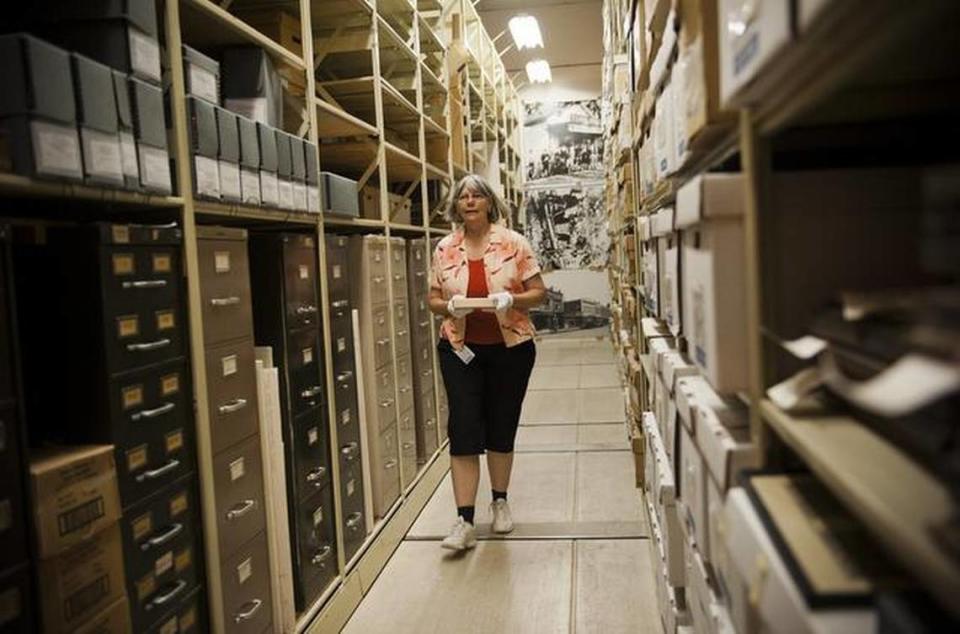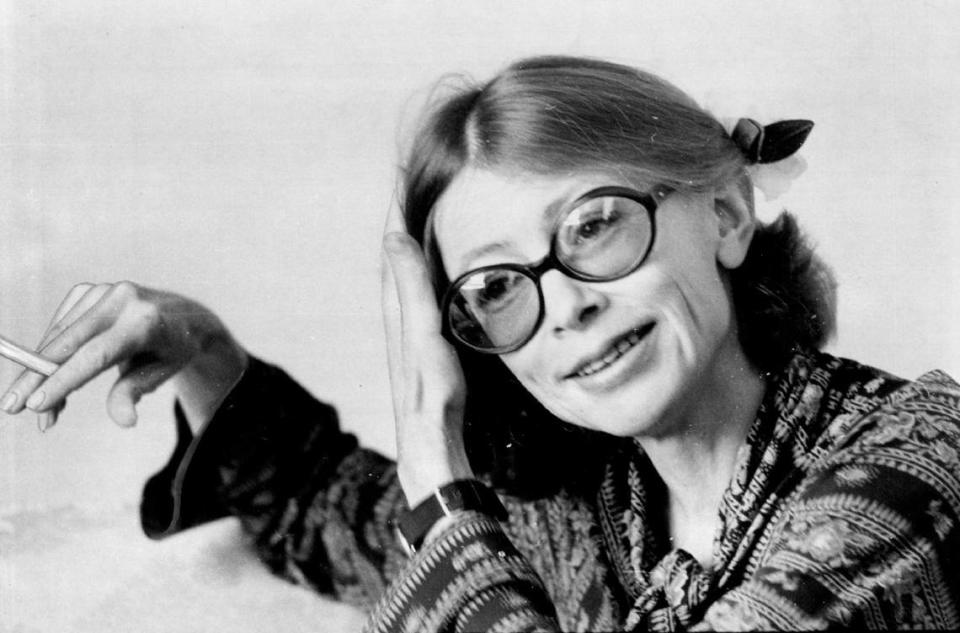Sacramento officials thought they would get $500K from Joan Didion’s estate. What happened?
City officials had hoped to get a $500,000 cut of the $900,000 donation Joan Didion’s estate made earlier this year to the Sacramento Historical Society.
The municipal budget approved by the Sacramento City Council on June 15 included the donation and stated it would go toward a new building for the Center for Sacramento History, home to the city’s historical archives.
It turns out, the city won’t be receiving any funds from the deceased Sacramento-born writer’s estate. Historical Society officials said they have withdrawn from potential plans to disperse a portion of the Didion estate’s donation to the city because city officials have failed to provide concrete plans for using that money to move their historical archives from a single story warehouse on Richard’s Boulevard to a location that is less vulnerable to flooding.
The Center for Sacramento History, which houses millions of historical records, is located a block and a half from the America River and less than a mile from its confluence with the Sacramento river, a feature that pushes the metropolitan area toward the top of the Army Corp of Engineers’ most at risk areas for flooding.
“We wanted to potentially support a solution for a new building on a collaborative basis,” historical society Vice President Gregg Lukenbill said.
Lukenbill said city officials weren’t willing to work together.
In August 2022, he wrote to Sacramento Mayor Darrell Steinberg, “It is simply not IF it’s WHEN the inevitable happens here,” referring to a major flood that could destroy the historical center’s artifacts.
Steinberg never responded, Lukenbill said.
Steinberg spokeswoman Mary Lynne Vellinga said the city made it clear they supported the effort to move the center and that Lukenbill sent a flurry of emails on the topic.
“I strongly support the Center for Sacramento History and its ongoing effort to locate a new space where its artifacts and records can be stored safely, and which can also be opened for regular public visitation,” Steinberg said in a statement to the Bee.
Despite his position, the city has not listed a future new building for the center in its proposed capital plans between now and 2028.
Historical Society President Bill White, the former Sacramento Fire Chief, said the society needs to set performance standards to ensure the Didion money is spent wisely.
He said the historical society can’t just give the city money without a commitment for a new building.
“We want to ensure that Joan’s legacy is preserved,” he said.
How did the Didion estate donation get in the city budget?
City of Sacramento spokeswoman Jennifer Singer said the wording in the budget that the city had received the half million in funding for a historical archives new building was “a mistake.” The budget should have stated that the city was seeking a $500,000 donation from the historical society.
“The city was in conversation with the historical society and Didion family about the funding but the funding was not secured,” she said.
Lukenbill said he came up with a plan to help the Center for Historical Research earlier this year after the society had money in its hand from the Didion estate.
“The conversation about supporting the city politicians addressing the egregious risk to the oldest historical records in the West was posited by me to the SHS board in April of this year,” he said.
Lukenbill said he met in April with Assistant City Manager Michael Jasso and city Cultural and Creative Economy Manager Megan Van Voorhis, who oversees the Center for Sacramento History, to discuss a new building.
Lukenbill called the conversation “one of the most pointless meetings I ever had in my life.”
City officials declined to comment about the meeting.
What’s at risk if the Center for Sacramento History floods?
City Historian Marcia Eymann, a leader at the Center for Sacramento History, shares the concern about flooding.
“There is the potential that these collections could be permanently destroyed because of flooding and that’s something the city has to be very realistic about,” she said.
Eymann said with climate change the danger is worsening each year, noting that a repeat of this year’s frequent winter rainstorms could threaten the archives in a matter of months.
The center’s collections go back to 1846 and include more than 8 million photos from The Sacramento Bee and other private collections and more than 15 million feet of moving image film from television stations KCRA and KOVR.

Kelly Didion, Joan Didion’s niece, said she supports the historical society’s decision not to give the money to the Center for Sacramento History because a new building is uncertain.
“I’d like to know that they are really in the game to get the building,” she said. “I don’t see any point in giving them the money until they’ve committed to making that a reality.”
Eymann said she had met with Kelly Didion and they had discussed giving Joan Didion’s personal papers to the Center for Historical Research.
Kelly Didion said the center’s location in a flood zone “played a role” in donating those personal papers to the New York Public Library instead. Joan Didion’s deceased husband, writer John Gregory Dunne, was a New Yorker and the desire to donate their papers to the same institution was the determining factor in their decision.
Sacramento officials don’t dispute the building is in a flood zone and that historical records could be damaged or destroyed in a major flooding event.
“The City recognizes the ongoing concerns associated with the Center for Sacramento History’s location, especially in light of the valuable archives and resources that are stored there,” city spokeswoman Gabby Miller wrote in an email.
Miller said city officials are seeking solutions to support the center while “remaining mindful of the realities of our current fiscal outlook.”
Eymann said a new building would cost at least $14 million. She has created her own fundraising brochure in efforts to sway city officials to build a new facility.
How will the Sacramento Historical Society spend Didion’s money?
Kelly Didion said the Sacramento Historical Society is free to do with the money as it chooses with one stipulation that at least $300,000 be allocated to the Sacramento City College scholarship fund.
Joan Didion took classes at the college as a young woman before transferring to the University of California, Berkeley, where she majored in English. In fact, Didion’s estate money would have never found its way to the Sacramento Historical Society if it wasn’t for one of her City College classmates, 90-year-old Maurice Read.

“ I met her when I was a Sacramento City College freshman and she had just graduated from McClatchy High School,” Read said. “And we became friends and we used to study at the main library occasionally on a Friday night.”
Fast forward more than 70 years.
Read, a member of the historical society board, said he became upset when he read a newspaper op-ed piece after Didion’s death in 2021 explaining how the city of Sacramento had forgotten its most famous literary figure without a major monument.
The retired government affairs official came up with the idea of a fundraising campaign for a statue in Didion’s honor. The statute now stands in the California Room at Sacramento’s Central Library.
When fundraising exceeded the $40,000 for the statue, the idea of creating a scholarship fund in honor of Didion at Sacramento City College was born.
“It was surprising, there was more enthusiasm than I thought to honor Joan Didion,” Read said.
He wrote to Joan Didion’s agent who let Kelly Didion know about the Sacramento City scholarship program, eventually leading to the donation from the Didion family estate to the historical society.
Lukenbill said the final details are being negotiated with college officials, but he expects that the college will receive around $500,000 for the scholarship fund and faculty grants that support papers on Didion and societal issues she explored in her books.
In exchange, Lukenbill said, the college will name its instruction center, which includes its library, in honor of Didion.
Sacramento City College President Albert Garcia said an agreement has yet to be reached with the historical society.
“We are, of course, thrilled about the potential benefits for our students and facility should this gift be finalized, in whatever form it will take,” he said.
Lukenbill said the society is exploring various options for how to spend any money that remains after donating to City College. One possibility that has been discussed is to fund a documentary on the annual Guns and Hoses football game between the city’s police and fire departments.

